Organizational Change Management: Overcoming Resistance
VerifiedAdded on 2023/05/31
|7
|1506
|268
Essay
AI Summary
This essay delves into the critical aspects of organizational change management, emphasizing the significance of adapting to rapidly evolving internal and external business environments. It identifies key reasons for resistance to change, primarily stemming from employee perspectives, including age gaps, lack of effective communication, and cultural differences. The essay then explores practical strategies for mitigating resistance, such as implementing effective communication processes, engaging employees in the change management process, and utilizing the Lewin model of change to identify and address organizational gaps. By addressing these factors, managers can improve the long-term effectiveness of their change management initiatives. The essay references several scholarly sources to support its claims.
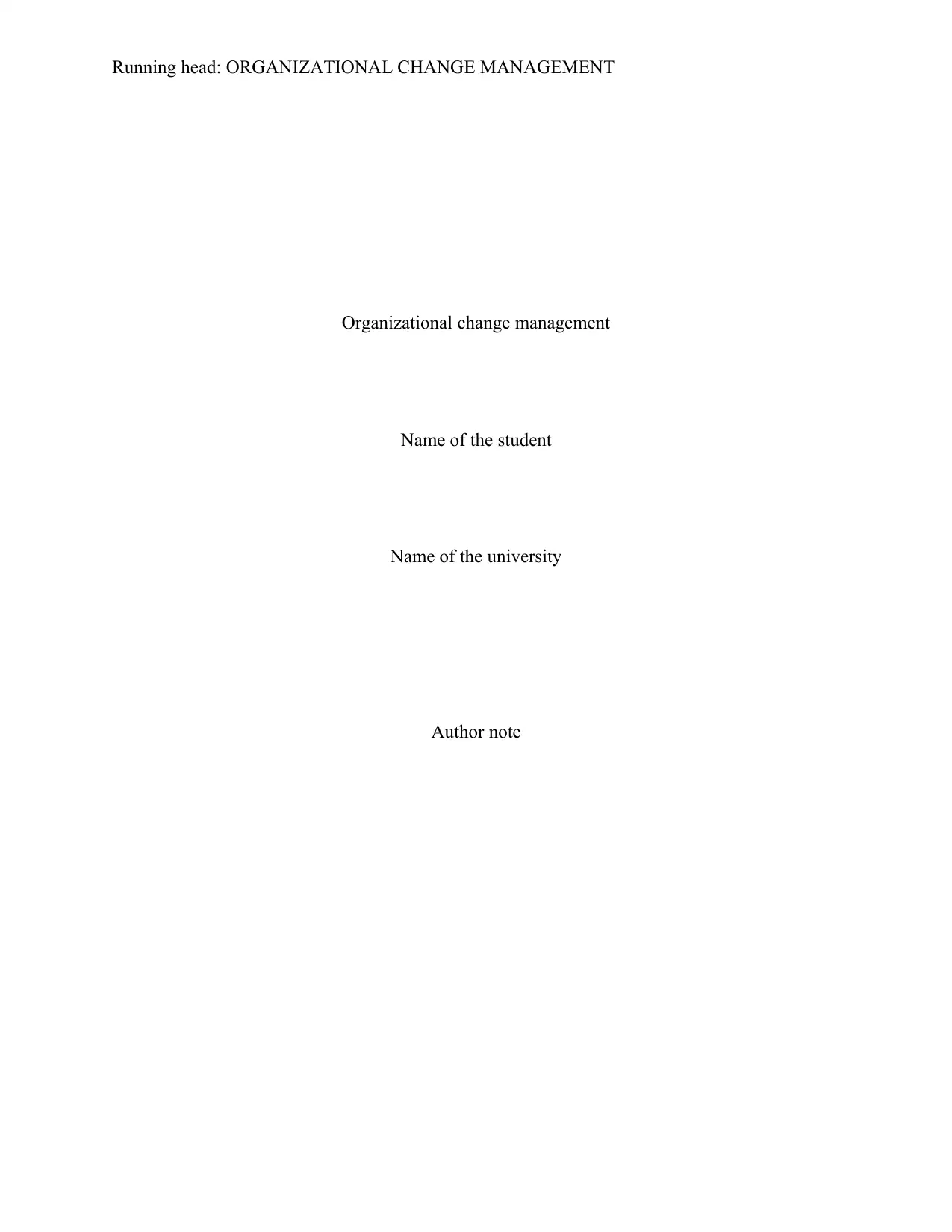
Running head: ORGANIZATIONAL CHANGE MANAGEMENT
Organizational change management
Name of the student
Name of the university
Author note
Organizational change management
Name of the student
Name of the university
Author note
Paraphrase This Document
Need a fresh take? Get an instant paraphrase of this document with our AI Paraphraser
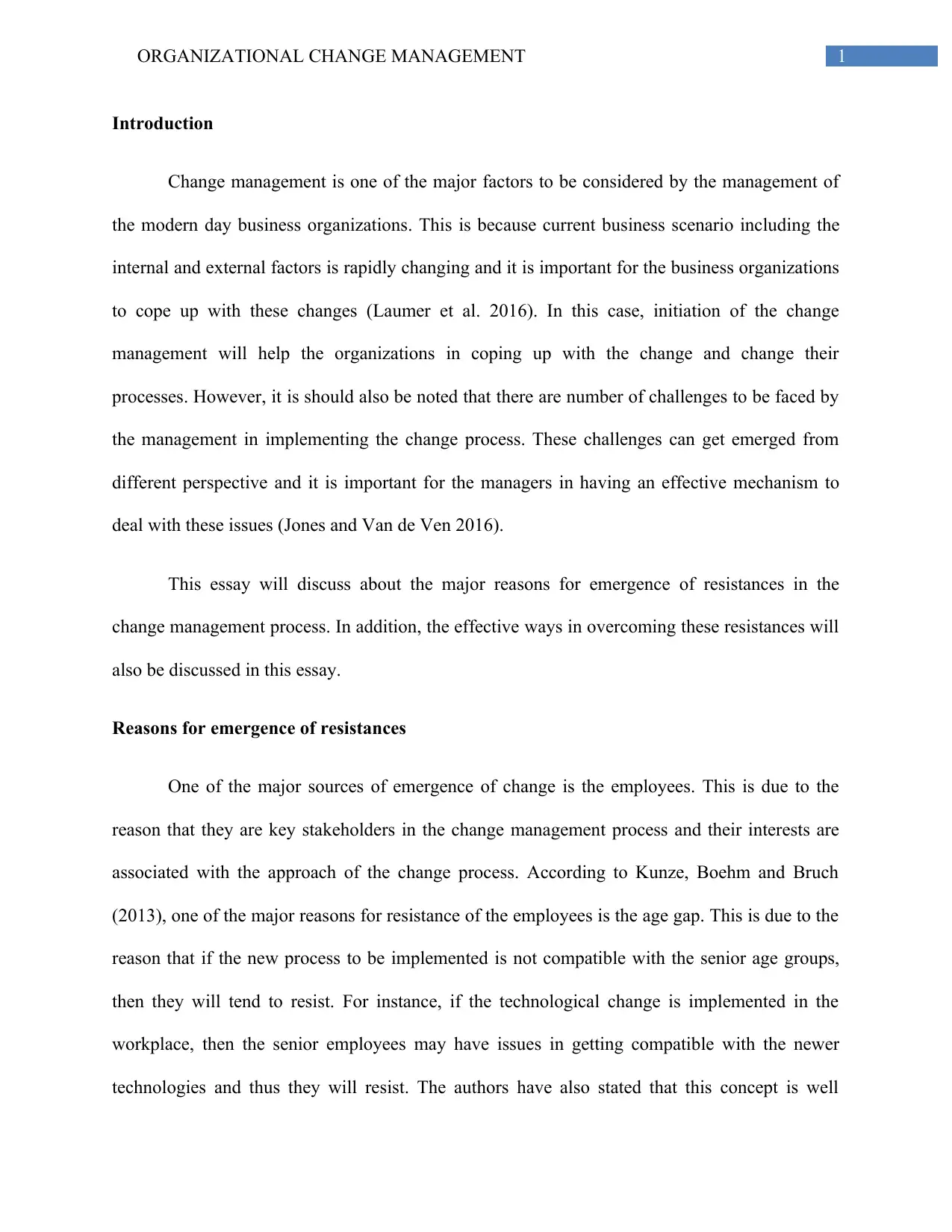
1ORGANIZATIONAL CHANGE MANAGEMENT
Introduction
Change management is one of the major factors to be considered by the management of
the modern day business organizations. This is because current business scenario including the
internal and external factors is rapidly changing and it is important for the business organizations
to cope up with these changes (Laumer et al. 2016). In this case, initiation of the change
management will help the organizations in coping up with the change and change their
processes. However, it is should also be noted that there are number of challenges to be faced by
the management in implementing the change process. These challenges can get emerged from
different perspective and it is important for the managers in having an effective mechanism to
deal with these issues (Jones and Van de Ven 2016).
This essay will discuss about the major reasons for emergence of resistances in the
change management process. In addition, the effective ways in overcoming these resistances will
also be discussed in this essay.
Reasons for emergence of resistances
One of the major sources of emergence of change is the employees. This is due to the
reason that they are key stakeholders in the change management process and their interests are
associated with the approach of the change process. According to Kunze, Boehm and Bruch
(2013), one of the major reasons for resistance of the employees is the age gap. This is due to the
reason that if the new process to be implemented is not compatible with the senior age groups,
then they will tend to resist. For instance, if the technological change is implemented in the
workplace, then the senior employees may have issues in getting compatible with the newer
technologies and thus they will resist. The authors have also stated that this concept is well
Introduction
Change management is one of the major factors to be considered by the management of
the modern day business organizations. This is because current business scenario including the
internal and external factors is rapidly changing and it is important for the business organizations
to cope up with these changes (Laumer et al. 2016). In this case, initiation of the change
management will help the organizations in coping up with the change and change their
processes. However, it is should also be noted that there are number of challenges to be faced by
the management in implementing the change process. These challenges can get emerged from
different perspective and it is important for the managers in having an effective mechanism to
deal with these issues (Jones and Van de Ven 2016).
This essay will discuss about the major reasons for emergence of resistances in the
change management process. In addition, the effective ways in overcoming these resistances will
also be discussed in this essay.
Reasons for emergence of resistances
One of the major sources of emergence of change is the employees. This is due to the
reason that they are key stakeholders in the change management process and their interests are
associated with the approach of the change process. According to Kunze, Boehm and Bruch
(2013), one of the major reasons for resistance of the employees is the age gap. This is due to the
reason that if the new process to be implemented is not compatible with the senior age groups,
then they will tend to resist. For instance, if the technological change is implemented in the
workplace, then the senior employees may have issues in getting compatible with the newer
technologies and thus they will resist. The authors have also stated that this concept is well
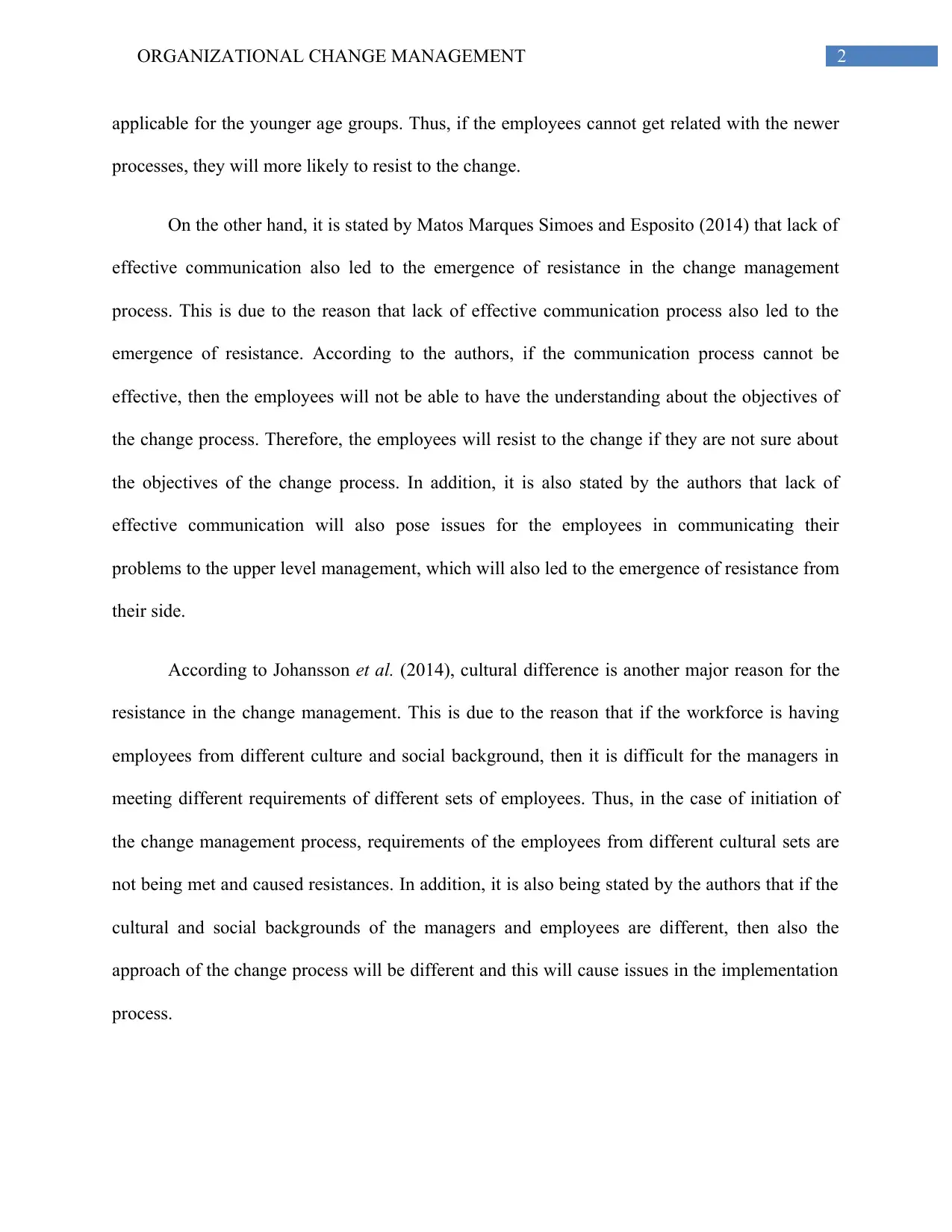
2ORGANIZATIONAL CHANGE MANAGEMENT
applicable for the younger age groups. Thus, if the employees cannot get related with the newer
processes, they will more likely to resist to the change.
On the other hand, it is stated by Matos Marques Simoes and Esposito (2014) that lack of
effective communication also led to the emergence of resistance in the change management
process. This is due to the reason that lack of effective communication process also led to the
emergence of resistance. According to the authors, if the communication process cannot be
effective, then the employees will not be able to have the understanding about the objectives of
the change process. Therefore, the employees will resist to the change if they are not sure about
the objectives of the change process. In addition, it is also stated by the authors that lack of
effective communication will also pose issues for the employees in communicating their
problems to the upper level management, which will also led to the emergence of resistance from
their side.
According to Johansson et al. (2014), cultural difference is another major reason for the
resistance in the change management. This is due to the reason that if the workforce is having
employees from different culture and social background, then it is difficult for the managers in
meeting different requirements of different sets of employees. Thus, in the case of initiation of
the change management process, requirements of the employees from different cultural sets are
not being met and caused resistances. In addition, it is also being stated by the authors that if the
cultural and social backgrounds of the managers and employees are different, then also the
approach of the change process will be different and this will cause issues in the implementation
process.
applicable for the younger age groups. Thus, if the employees cannot get related with the newer
processes, they will more likely to resist to the change.
On the other hand, it is stated by Matos Marques Simoes and Esposito (2014) that lack of
effective communication also led to the emergence of resistance in the change management
process. This is due to the reason that lack of effective communication process also led to the
emergence of resistance. According to the authors, if the communication process cannot be
effective, then the employees will not be able to have the understanding about the objectives of
the change process. Therefore, the employees will resist to the change if they are not sure about
the objectives of the change process. In addition, it is also stated by the authors that lack of
effective communication will also pose issues for the employees in communicating their
problems to the upper level management, which will also led to the emergence of resistance from
their side.
According to Johansson et al. (2014), cultural difference is another major reason for the
resistance in the change management. This is due to the reason that if the workforce is having
employees from different culture and social background, then it is difficult for the managers in
meeting different requirements of different sets of employees. Thus, in the case of initiation of
the change management process, requirements of the employees from different cultural sets are
not being met and caused resistances. In addition, it is also being stated by the authors that if the
cultural and social backgrounds of the managers and employees are different, then also the
approach of the change process will be different and this will cause issues in the implementation
process.
⊘ This is a preview!⊘
Do you want full access?
Subscribe today to unlock all pages.

Trusted by 1+ million students worldwide
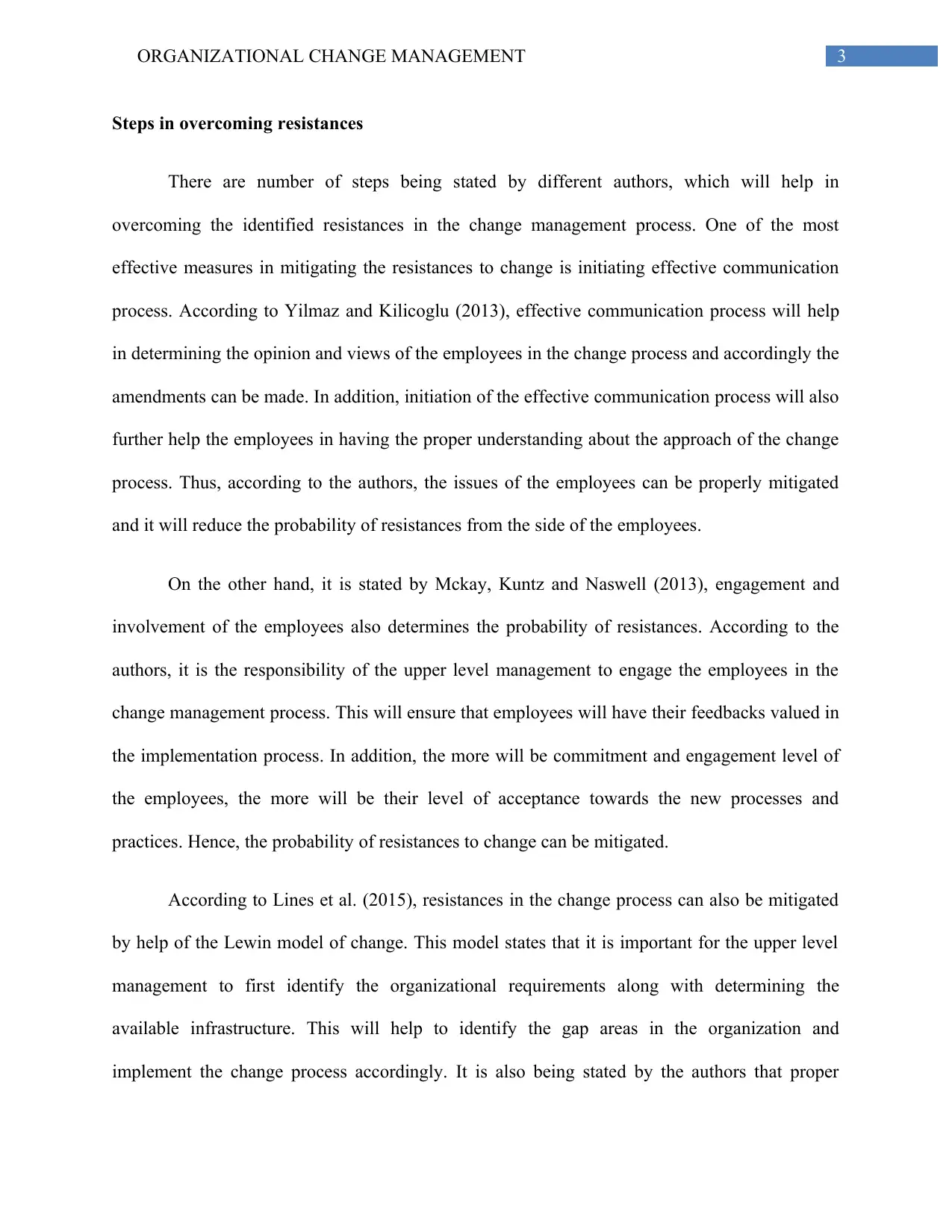
3ORGANIZATIONAL CHANGE MANAGEMENT
Steps in overcoming resistances
There are number of steps being stated by different authors, which will help in
overcoming the identified resistances in the change management process. One of the most
effective measures in mitigating the resistances to change is initiating effective communication
process. According to Yilmaz and Kilicoglu (2013), effective communication process will help
in determining the opinion and views of the employees in the change process and accordingly the
amendments can be made. In addition, initiation of the effective communication process will also
further help the employees in having the proper understanding about the approach of the change
process. Thus, according to the authors, the issues of the employees can be properly mitigated
and it will reduce the probability of resistances from the side of the employees.
On the other hand, it is stated by Mckay, Kuntz and Naswell (2013), engagement and
involvement of the employees also determines the probability of resistances. According to the
authors, it is the responsibility of the upper level management to engage the employees in the
change management process. This will ensure that employees will have their feedbacks valued in
the implementation process. In addition, the more will be commitment and engagement level of
the employees, the more will be their level of acceptance towards the new processes and
practices. Hence, the probability of resistances to change can be mitigated.
According to Lines et al. (2015), resistances in the change process can also be mitigated
by help of the Lewin model of change. This model states that it is important for the upper level
management to first identify the organizational requirements along with determining the
available infrastructure. This will help to identify the gap areas in the organization and
implement the change process accordingly. It is also being stated by the authors that proper
Steps in overcoming resistances
There are number of steps being stated by different authors, which will help in
overcoming the identified resistances in the change management process. One of the most
effective measures in mitigating the resistances to change is initiating effective communication
process. According to Yilmaz and Kilicoglu (2013), effective communication process will help
in determining the opinion and views of the employees in the change process and accordingly the
amendments can be made. In addition, initiation of the effective communication process will also
further help the employees in having the proper understanding about the approach of the change
process. Thus, according to the authors, the issues of the employees can be properly mitigated
and it will reduce the probability of resistances from the side of the employees.
On the other hand, it is stated by Mckay, Kuntz and Naswell (2013), engagement and
involvement of the employees also determines the probability of resistances. According to the
authors, it is the responsibility of the upper level management to engage the employees in the
change management process. This will ensure that employees will have their feedbacks valued in
the implementation process. In addition, the more will be commitment and engagement level of
the employees, the more will be their level of acceptance towards the new processes and
practices. Hence, the probability of resistances to change can be mitigated.
According to Lines et al. (2015), resistances in the change process can also be mitigated
by help of the Lewin model of change. This model states that it is important for the upper level
management to first identify the organizational requirements along with determining the
available infrastructure. This will help to identify the gap areas in the organization and
implement the change process accordingly. It is also being stated by the authors that proper
Paraphrase This Document
Need a fresh take? Get an instant paraphrase of this document with our AI Paraphraser
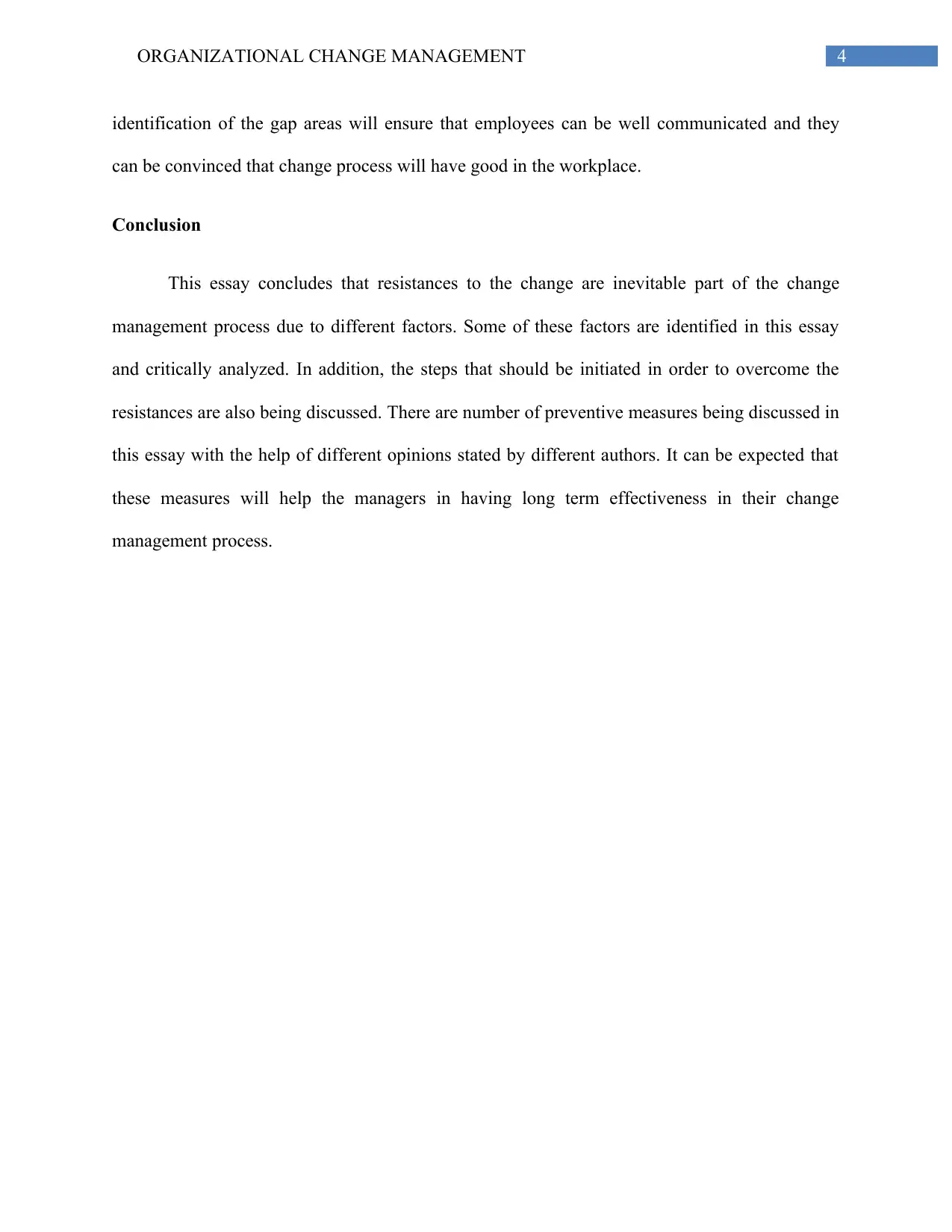
4ORGANIZATIONAL CHANGE MANAGEMENT
identification of the gap areas will ensure that employees can be well communicated and they
can be convinced that change process will have good in the workplace.
Conclusion
This essay concludes that resistances to the change are inevitable part of the change
management process due to different factors. Some of these factors are identified in this essay
and critically analyzed. In addition, the steps that should be initiated in order to overcome the
resistances are also being discussed. There are number of preventive measures being discussed in
this essay with the help of different opinions stated by different authors. It can be expected that
these measures will help the managers in having long term effectiveness in their change
management process.
identification of the gap areas will ensure that employees can be well communicated and they
can be convinced that change process will have good in the workplace.
Conclusion
This essay concludes that resistances to the change are inevitable part of the change
management process due to different factors. Some of these factors are identified in this essay
and critically analyzed. In addition, the steps that should be initiated in order to overcome the
resistances are also being discussed. There are number of preventive measures being discussed in
this essay with the help of different opinions stated by different authors. It can be expected that
these measures will help the managers in having long term effectiveness in their change
management process.
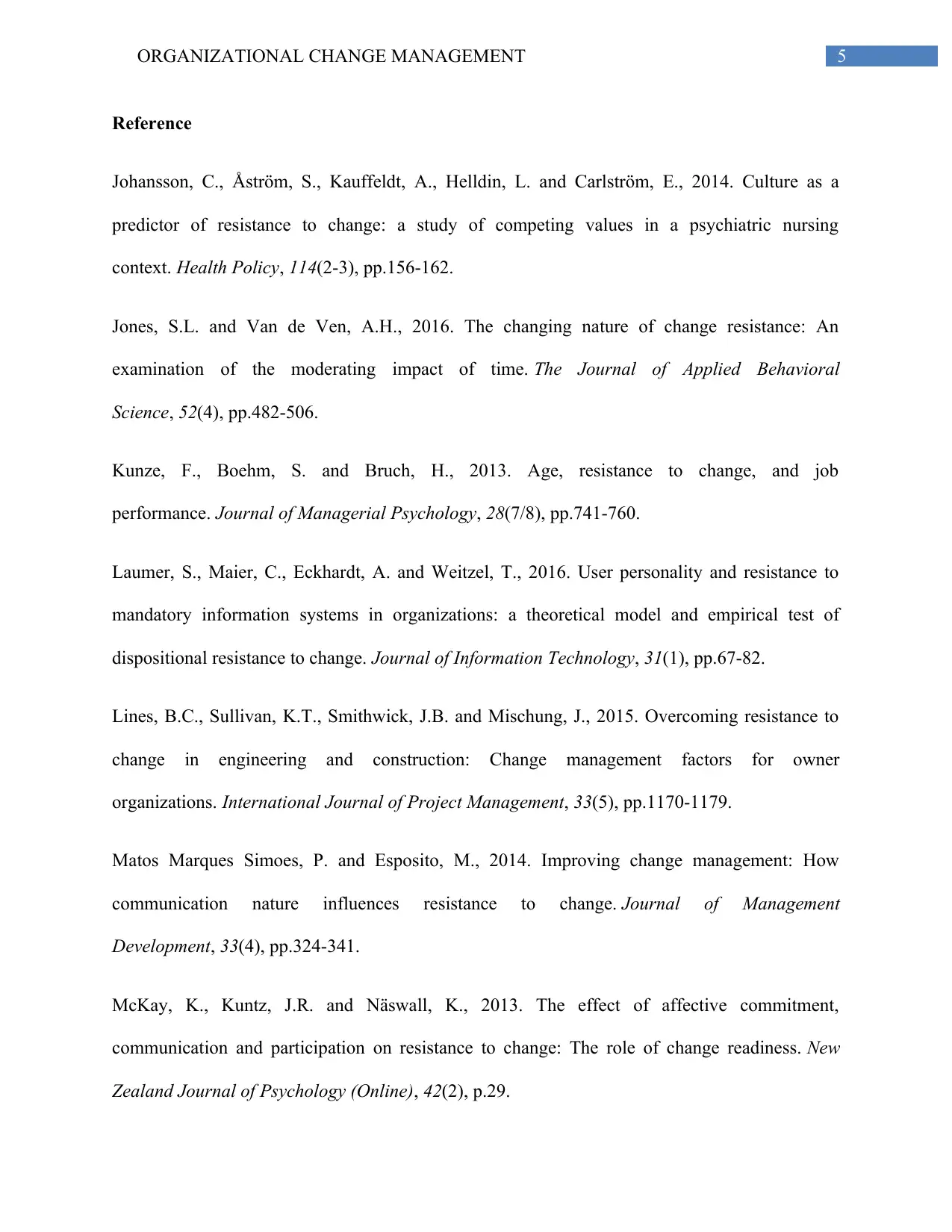
5ORGANIZATIONAL CHANGE MANAGEMENT
Reference
Johansson, C., Åström, S., Kauffeldt, A., Helldin, L. and Carlström, E., 2014. Culture as a
predictor of resistance to change: a study of competing values in a psychiatric nursing
context. Health Policy, 114(2-3), pp.156-162.
Jones, S.L. and Van de Ven, A.H., 2016. The changing nature of change resistance: An
examination of the moderating impact of time. The Journal of Applied Behavioral
Science, 52(4), pp.482-506.
Kunze, F., Boehm, S. and Bruch, H., 2013. Age, resistance to change, and job
performance. Journal of Managerial Psychology, 28(7/8), pp.741-760.
Laumer, S., Maier, C., Eckhardt, A. and Weitzel, T., 2016. User personality and resistance to
mandatory information systems in organizations: a theoretical model and empirical test of
dispositional resistance to change. Journal of Information Technology, 31(1), pp.67-82.
Lines, B.C., Sullivan, K.T., Smithwick, J.B. and Mischung, J., 2015. Overcoming resistance to
change in engineering and construction: Change management factors for owner
organizations. International Journal of Project Management, 33(5), pp.1170-1179.
Matos Marques Simoes, P. and Esposito, M., 2014. Improving change management: How
communication nature influences resistance to change. Journal of Management
Development, 33(4), pp.324-341.
McKay, K., Kuntz, J.R. and Näswall, K., 2013. The effect of affective commitment,
communication and participation on resistance to change: The role of change readiness. New
Zealand Journal of Psychology (Online), 42(2), p.29.
Reference
Johansson, C., Åström, S., Kauffeldt, A., Helldin, L. and Carlström, E., 2014. Culture as a
predictor of resistance to change: a study of competing values in a psychiatric nursing
context. Health Policy, 114(2-3), pp.156-162.
Jones, S.L. and Van de Ven, A.H., 2016. The changing nature of change resistance: An
examination of the moderating impact of time. The Journal of Applied Behavioral
Science, 52(4), pp.482-506.
Kunze, F., Boehm, S. and Bruch, H., 2013. Age, resistance to change, and job
performance. Journal of Managerial Psychology, 28(7/8), pp.741-760.
Laumer, S., Maier, C., Eckhardt, A. and Weitzel, T., 2016. User personality and resistance to
mandatory information systems in organizations: a theoretical model and empirical test of
dispositional resistance to change. Journal of Information Technology, 31(1), pp.67-82.
Lines, B.C., Sullivan, K.T., Smithwick, J.B. and Mischung, J., 2015. Overcoming resistance to
change in engineering and construction: Change management factors for owner
organizations. International Journal of Project Management, 33(5), pp.1170-1179.
Matos Marques Simoes, P. and Esposito, M., 2014. Improving change management: How
communication nature influences resistance to change. Journal of Management
Development, 33(4), pp.324-341.
McKay, K., Kuntz, J.R. and Näswall, K., 2013. The effect of affective commitment,
communication and participation on resistance to change: The role of change readiness. New
Zealand Journal of Psychology (Online), 42(2), p.29.
⊘ This is a preview!⊘
Do you want full access?
Subscribe today to unlock all pages.

Trusted by 1+ million students worldwide
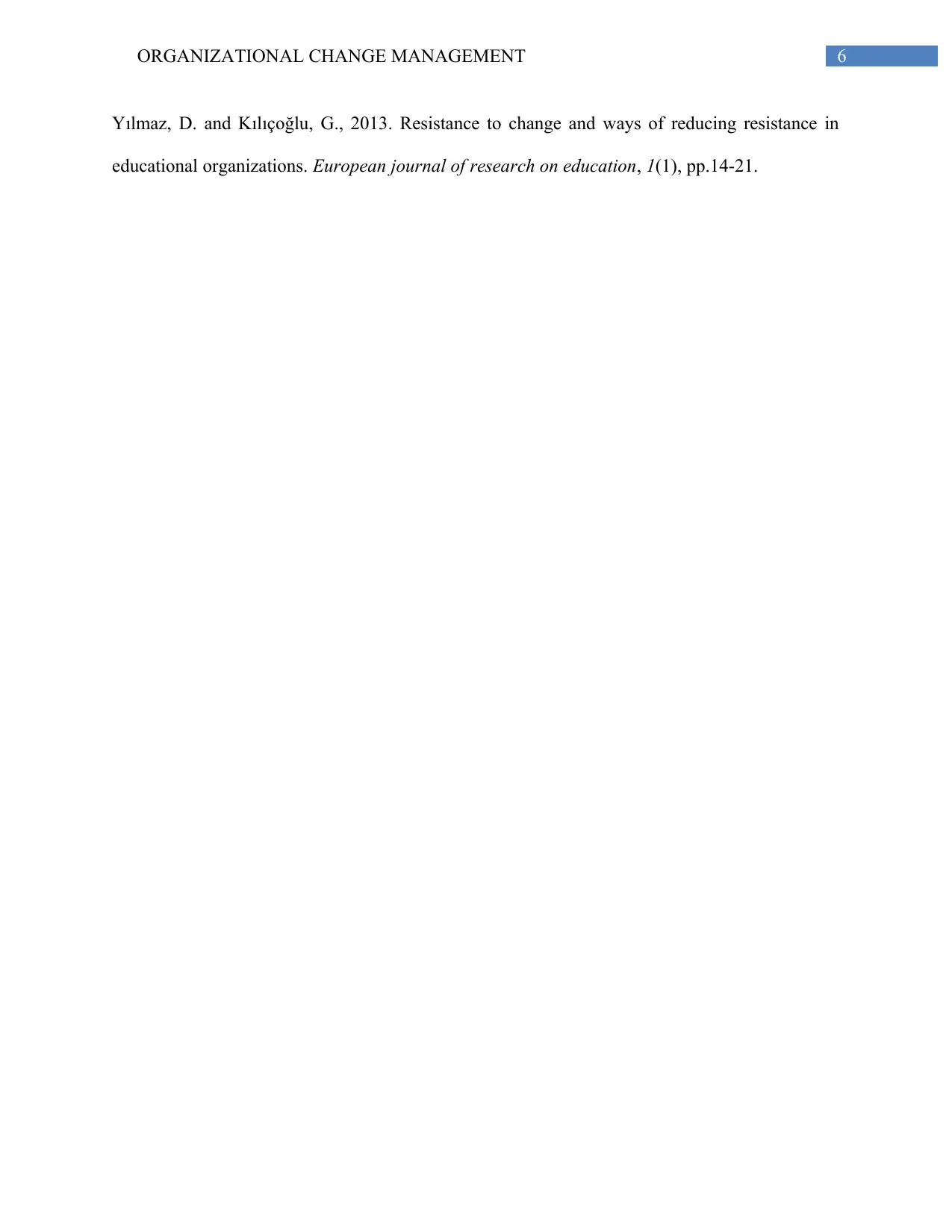
6ORGANIZATIONAL CHANGE MANAGEMENT
Yılmaz, D. and Kılıçoğlu, G., 2013. Resistance to change and ways of reducing resistance in
educational organizations. European journal of research on education, 1(1), pp.14-21.
Yılmaz, D. and Kılıçoğlu, G., 2013. Resistance to change and ways of reducing resistance in
educational organizations. European journal of research on education, 1(1), pp.14-21.
1 out of 7
Related Documents
Your All-in-One AI-Powered Toolkit for Academic Success.
+13062052269
info@desklib.com
Available 24*7 on WhatsApp / Email
![[object Object]](/_next/static/media/star-bottom.7253800d.svg)
Unlock your academic potential
Copyright © 2020–2025 A2Z Services. All Rights Reserved. Developed and managed by ZUCOL.





